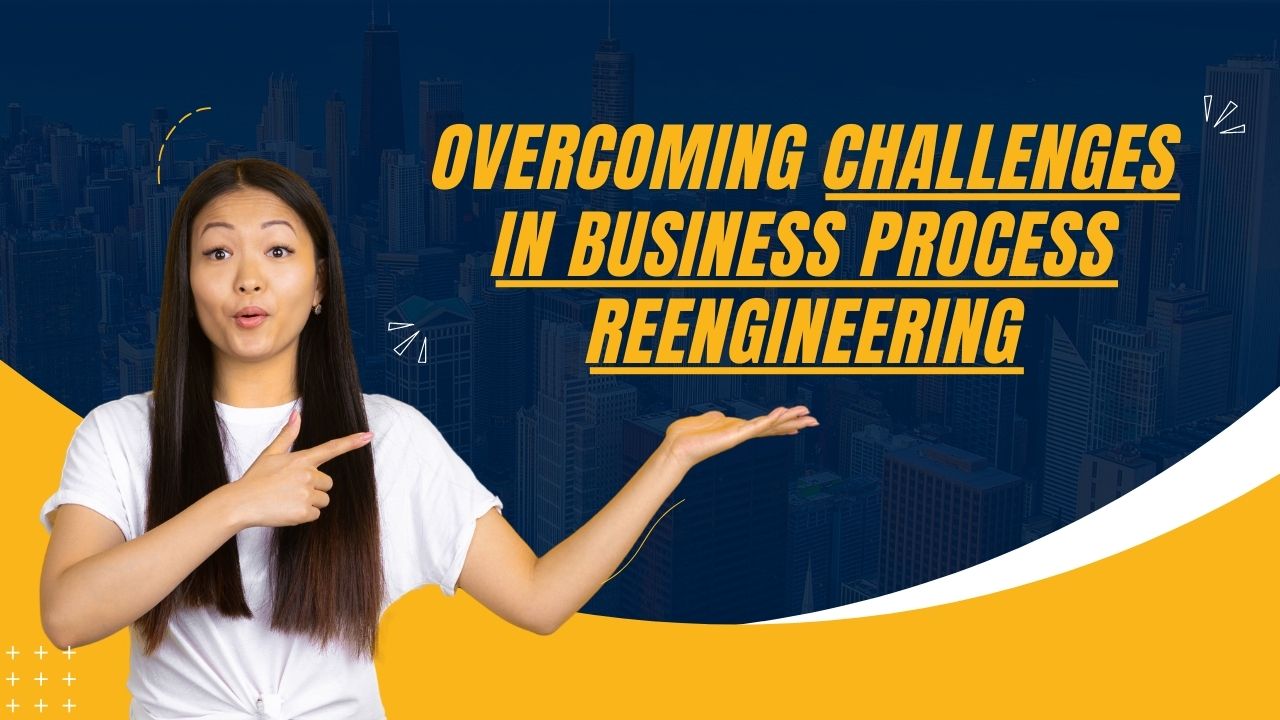by Subhadeep Chowdhury
Share

In today’s ever-evolving business landscape, the need for agility and efficiency is paramount. This has led to the widespread adoption of Business Process Reengineering (BPR), a strategic approach aimed at radically transforming and improving organizational processes. However, while the promise of BPR is significant, it comes with its fair share of challenges.
Here, today, in this blog post, we will delve into the world of Business Process Reengineering and explore the key hurdles that organizations face when attempting to streamline their operations. Understanding these challenges is the first step towards successfully implementing BPR and reaping its rewards.
What is BPR or Business Process Reengineering?
Business Process Reengineering (BPR) has emerged as a critical strategy for organizations striving to stay competitive and adapt to changing market dynamics. The core objective of BPR is to redesign and optimize existing processes to enhance efficiency, reduce costs, and improve overall performance. While the benefits are undeniable, the journey toward successful BPR is fraught with challenges that can impede progress and potentially derail the entire initiative.
In this blog, we will explore the formidable challenges that businesses encounter when embarking on the path of Business Process Reengineering. By recognizing and addressing these obstacles, organizations can better navigate the reengineering process and increase the likelihood of achieving their desired outcomes.
Challenges in Business Process Reengineering and How to Overcome Them
-
Resistance to Change:
One of the most significant hurdles in Business Process Reengineering is the inherent resistance to change within an organization. Employees are often accustomed to the status quo and are naturally apprehensive about the prospect of process transformation. This resistance can manifest in various forms, including reluctance to adopt new technologies, skepticism about the benefits of change, and fear of job insecurity.
To address this challenge, organizations must invest in change management strategies. These strategies should focus on communication, training, and creating a culture of collaboration and innovation. By involving employees in the BPR process and demonstrating the positive impact on their roles and the organization as a whole, resistance can be minimized.
Also read: What Is Business Process Reengineering In ERP?
-
Lack of Clear Objectives:
Another common stumbling block in Business Process Reengineering is the absence of clear and well-defined objectives. Importance of Setting Clear Goals in BPR:
Setting clear and well-defined goals is paramount in the context of Business Process Reengineering (BPR). BPR involves substantial organizational changes aimed at improving processes, reducing costs, enhancing efficiency, and increasing competitiveness. Here’s why having clear goals is essential:
- Direction and Focus: Clear goals provide a sense of direction for the entire BPR initiative. They give the project a purpose and help align efforts toward achieving specific outcomes. Without clear goals, the project may lack direction and result in a haphazard approach to change.
- Measurability: Well-defined goals are measurable and quantifiable. This allows organizations to track progress, assess the impact of changes, and determine whether the BPR initiative is achieving its intended results. It enables data-driven decision-making.
- Motivation and Buy-In: Clear goals provide motivation and buy-in from employees and stakeholders. When individuals understand what the organization is trying to achieve, they are more likely to support and actively participate in the change process.
- Resource Allocation: Having clear goals helps in allocating resources effectively. Organizations can allocate budget, manpower, and technology based on the specific objectives, ensuring that resources are utilized efficiently.
How Vague Objectives Can Lead to Confusion and Inefficiency:
Vague or poorly defined objectives in BPR can have detrimental effects on the project’s success:
- Confusion: When goals are not clear, employees and teams may have different interpretations of what needs to be achieved. This can lead to confusion, misalignment of efforts, and conflicting priorities, resulting in a chaotic work environment.
- Inefficiency: Without clear objectives, organizations may invest time and resources in activities that do not contribute directly to the intended outcomes. This inefficiency can lead to wasted resources, delayed project timelines, and increased costs.
- Resistance to Change: Ambiguity in goals can breed skepticism and resistance among employees. They may be hesitant to embrace changes when they do not understand the ultimate purpose, leading to resistance that can derail the BPR initiative.
- Lack of Accountability: Unclear goals make it difficult to hold individuals or teams accountable for their contributions to the project. This can result in a lack of ownership and responsibility, hampering progress.
Also read: What Does Business Process Reengineering Involve?
-
Communication Breakdown:
Effective communication plays a pivotal role in the success of Business Process Reengineering (BPR). In the context of BPR, communication encompasses not only conveying information but also fostering understanding, collaboration, and buy-in among all stakeholders, from top management to front-line employees. Here’s why effective communication is crucial and strategies to improve it within an organization undergoing BPR:
Importance of Effective Communication:
Effective communication is the linchpin of BPR for several reasons:
- Clarity of Objectives: BPR initiatives often involve significant changes that can create uncertainty. Clear and transparent communication helps in articulating the objectives, benefits, and expected outcomes of the reengineering effort, reducing ambiguity and anxiety among employees.
- Alignment: BPR necessitates cross-functional collaboration and consensus. Proper communication ensures that all stakeholders, including different departments and team members, are on the same page, aligning their efforts toward the common goals of the project
- Mitigating Resistance: Resistance to change is a common challenge in BPR. Open and honest communication channels allow employees to voice concerns, seek clarifications, and feel heard, which can reduce resistance and foster a more positive attitude toward the changes.
Strategies for Improving Communication within the Organization:
To overcome communication breakdowns during BPR, organizations can implement the following strategies:
- Stakeholder Involvement: Involve key stakeholders at every stage of the BPR process. Seek their input, feedback, and ideas, and ensure that they understand the rationale behind the changes.
- Clear Communication Plans: Develop comprehensive communication plans that outline what needs to be communicated, when, and to whom. This can include regular meetings, newsletters, workshops, and other methods to keep everyone informed
- Training and Education: Provide training sessions and resources to ensure that employees understand new processes and technologies. Effective training can reduce misunderstandings and errors during the transition.
- Feedback Loops: Establish mechanisms for employees to provide feedback on the ongoing changes. Regularly review and address concerns and suggestions to demonstrate that their input is valued.
Also read: When Should Business Process Reengineering Be Used
-
Technology Integration:
In today’s digital age, technology plays a central role in Business Process Reengineering. While leveraging technology can lead to significant process improvements, integrating new systems and tools can be a complex and daunting task. Compatibility issues, data migration challenges, and disruptions during implementation can hinder the success of BPR initiatives.
To address this challenge, organizations should conduct a thorough technology assessment and select solutions that align with their existing infrastructure and long-term goals. Additionally, investing in robust training programs for employees is crucial to ensure they can effectively utilize the new technology. Partnering with experienced technology vendors or consultants can also help navigate the complexities of integration.
-
Lack of Leadership and Governance
Effective leadership and governance are pivotal to the success of Business Process Reengineering. Without strong leadership and a well-defined governance structure, BPR initiatives may lack direction, accountability, and the necessary support from top management. This can result in a lack of resources, unclear decision-making processes, and inadequate risk management.
To overcome this challenge, organizations should appoint a dedicated BPR team led by an experienced project manager. This team should work closely with executive leadership to ensure alignment with the organization’s strategic vision. Clear roles and responsibilities, along with regular reporting and communication channels, should be established to maintain transparency and accountability throughout the reengineering process.
NOTE:
In the dynamic landscape of modern business, the need for agile adaptation and optimization is paramount. “Overcoming Challenges in Business Process Reengineering” delves into the essential strategies and methodologies required to navigate the complexities of reengineering business processes effectively. At Econstra, our expertise lies not only in business consultancy but also in providing cutting-edge tools and systems for business automation, empowering organizations to streamline their operations and drive sustainable growth. Through a comprehensive approach that encompasses thorough analysis, strategic planning, and seamless implementation, we enable businesses to overcome obstacles and capitalize on opportunities for innovation and efficiency. By embracing change and harnessing the power of technology, businesses can transform their operations, enhance competitiveness, and thrive in today’s ever-evolving marketplace.
Conclusion: Challenges in Business Process Reengineering
In conclusion, Business Process Reengineering offers immense potential for organizations to enhance their efficiency, reduce costs, and stay competitive in today’s dynamic business environment. However, to unlock these benefits, it is crucial to address the challenges that can impede the successful implementation of BPR.
Challenges such as resistance to change, lack of clear objectives, technology integration issues, and the absence of strong leadership and governance can all pose significant obstacles. By acknowledging and proactively tackling these challenges, organizations can increase the likelihood of achieving their BPR goals.
Embracing change, setting clear objectives, carefully integrating technology, and establishing strong leadership and governance are essential steps in navigating the complexities of Business Process Reengineering. With the right strategies and a commitment to continuous improvement, organizations can not only overcome these challenges but also transform their processes for sustainable success in the modern business landscape. Business Process Reengineering is a powerful tool, and with the right approach, it can propel organizations towards a brighter and more efficient future.
STAY IN THE LOOP
Subscribe to our free newsletter.
Business consultant services provide the strategic insight and expertise necessary to steer your company through various challenges and opportunities. These professionals play a crucial role in helping businesses identify growth opportunities, optimize operations, and achieve long-term success. Understanding the Role of a Business Consultant A business consultant acts as an external advisor who brings a […]
In today’s competitive business landscape, companies are constantly seeking ways to reduce operational costs while maintaining or improving efficiency and customer satisfaction. Customer Relationship Management (CRM) systems have emerged as vital tools that enable businesses to achieve these goals. As a leading business consultancy, Econstra understands the importance of leveraging CRM technology to streamline operations, […]
Why Operational Costs Are Draining Your Profits? Operational costs are a critical aspect of running a successful business, but when not managed properly, they can drain your profits and stifle growth. In a competitive market, maintaining profitability requires keen oversight of expenses and strategic planning. Econstra, as a leading business consultancy, provides insights and strategies […]
In the rapidly advancing digital landscape, Artificial Intelligence (AI) tools have emerged as transformative assets for businesses. Their potential to enhance efficiency, streamline operations, and drive innovation makes them invaluable for business consultants and organizations worldwide. For business consultants in India, AI’s strategic application can be particularly advantageous in navigating a diverse and dynamic market. […]





